Mika Rottenberg
05 Jun - 03 Nov 2024
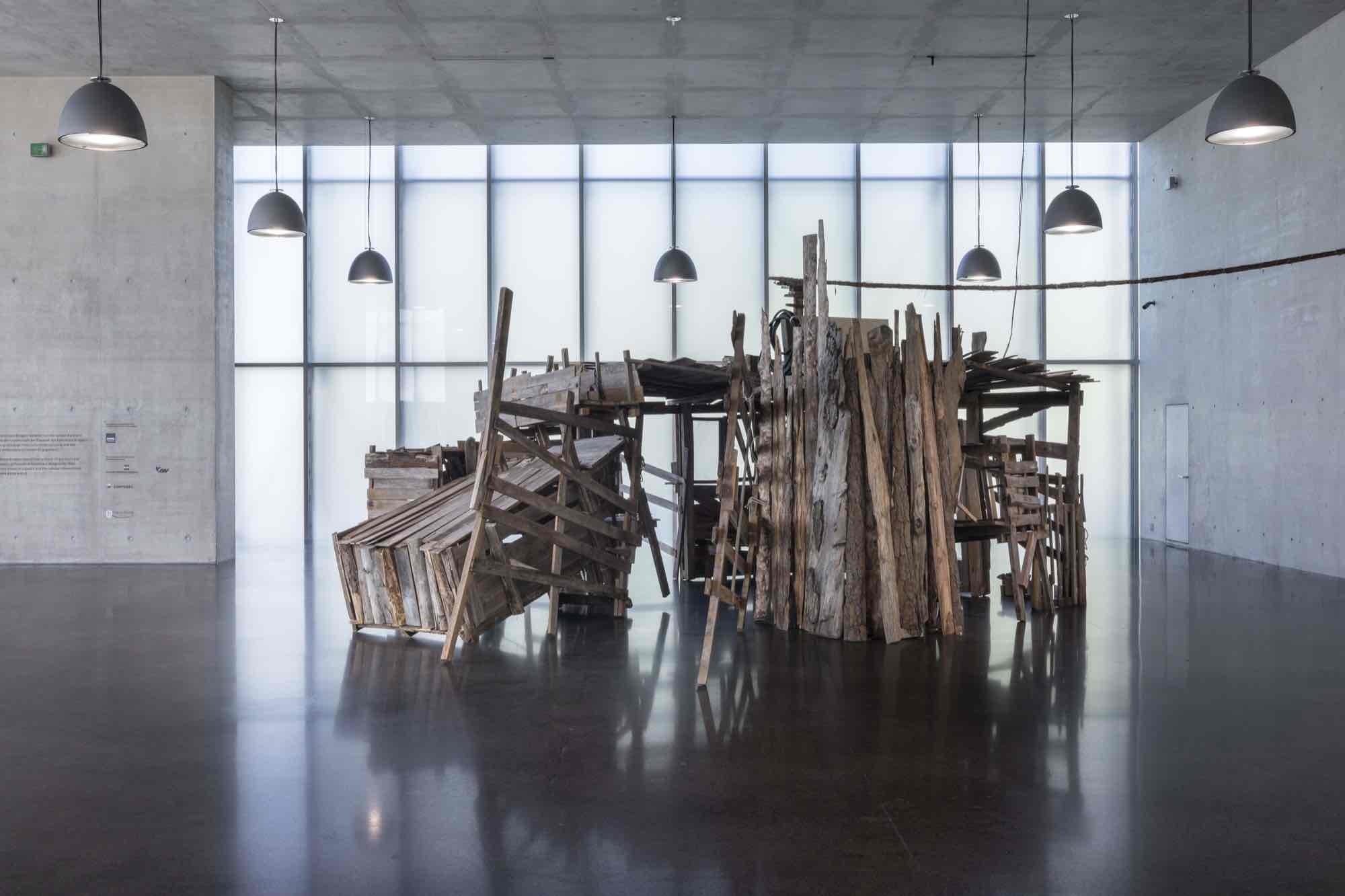
Mika Rottenberg, Cheese, 2008
Multichannel video installation with sound; 16:07 min.
Dimensions variable
Installation view of Mika Rottenberg at Kunsthaus Bregenz,
Austria, 2018.
© Mika Rottenberg, Courtesy the artist and Hauser & Wirth
Photo: Markus Tretter
Multichannel video installation with sound; 16:07 min.
Dimensions variable
Installation view of Mika Rottenberg at Kunsthaus Bregenz,
Austria, 2018.
© Mika Rottenberg, Courtesy the artist and Hauser & Wirth
Photo: Markus Tretter
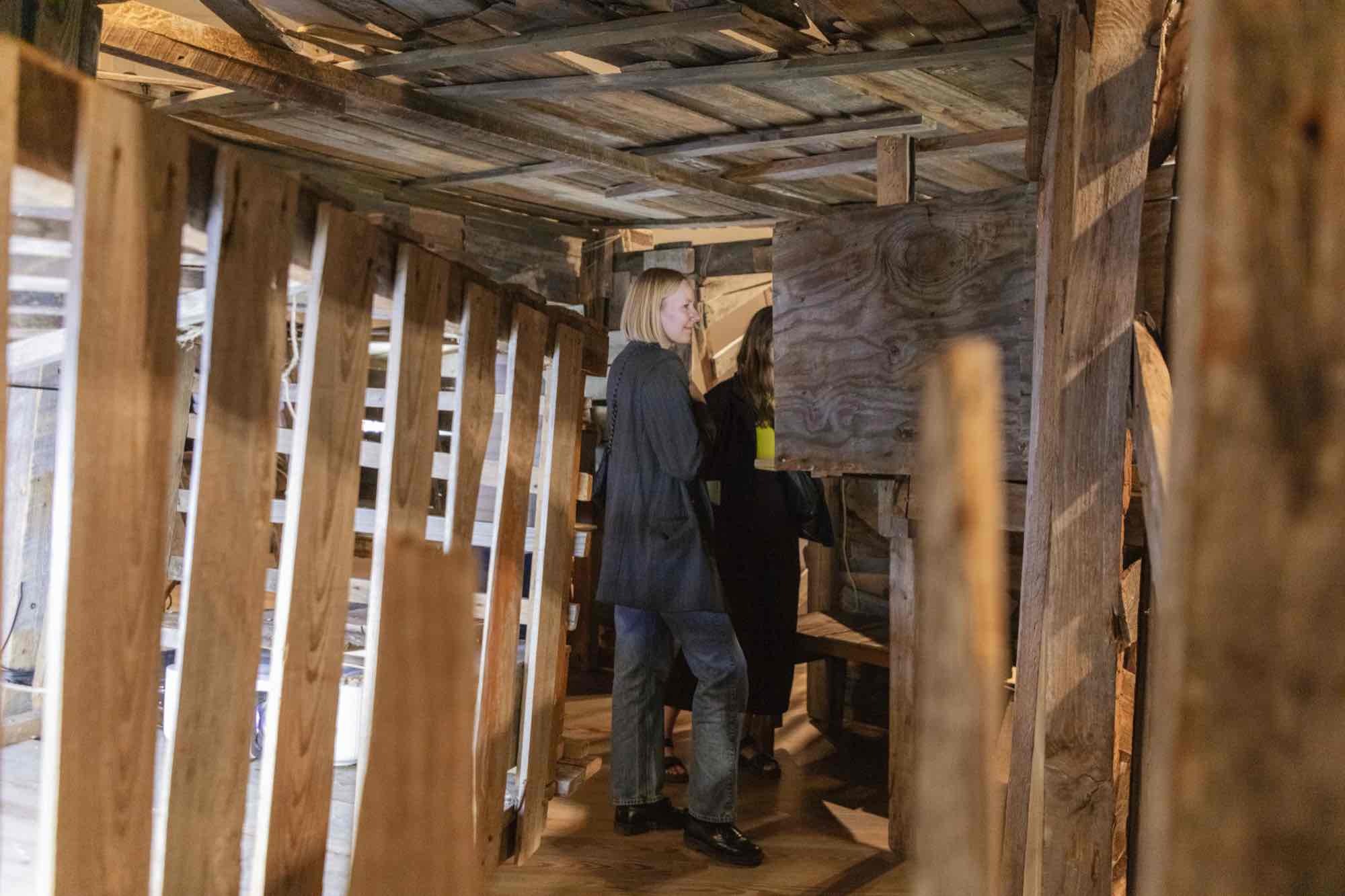
Mika Rottenberg, Cheese, 2008
Multichannel video installation with sound; 16:07 min.
Dimensions variable
Installation view Mika Rottenberg. Antimatter Factory
at Museum Tinguely, Basel, 2024
© Mika Rottenberg, Courtesy the artist and Hauser & Wirth
Photo: 2024 Museum Tinguely, Basel; Pati Grabowicz
Multichannel video installation with sound; 16:07 min.
Dimensions variable
Installation view Mika Rottenberg. Antimatter Factory
at Museum Tinguely, Basel, 2024
© Mika Rottenberg, Courtesy the artist and Hauser & Wirth
Photo: 2024 Museum Tinguely, Basel; Pati Grabowicz
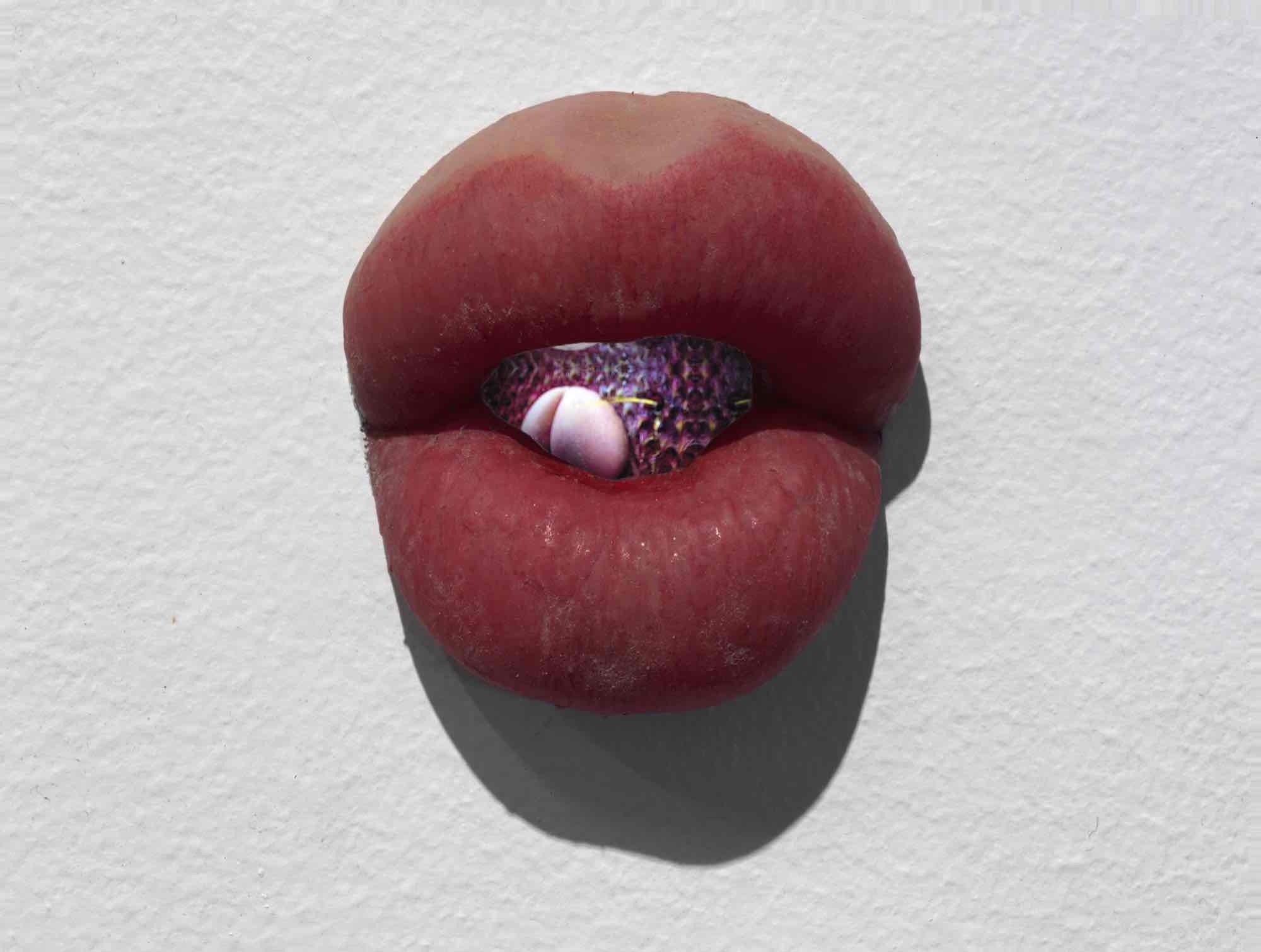
Mika Rottenberg, Lips (Study #3), 2016/19
Single-channel video installation, sound, colour; 1:28 min.
Dimensions variable
Installation view of Mika Rottenberg: Easypieces, 2019,
New Museum, New York.
© Mika Rottenberg, Courtesy the artist and Hauser & Wirth
Photo: Dario Lasagni
Single-channel video installation, sound, colour; 1:28 min.
Dimensions variable
Installation view of Mika Rottenberg: Easypieces, 2019,
New Museum, New York.
© Mika Rottenberg, Courtesy the artist and Hauser & Wirth
Photo: Dario Lasagni
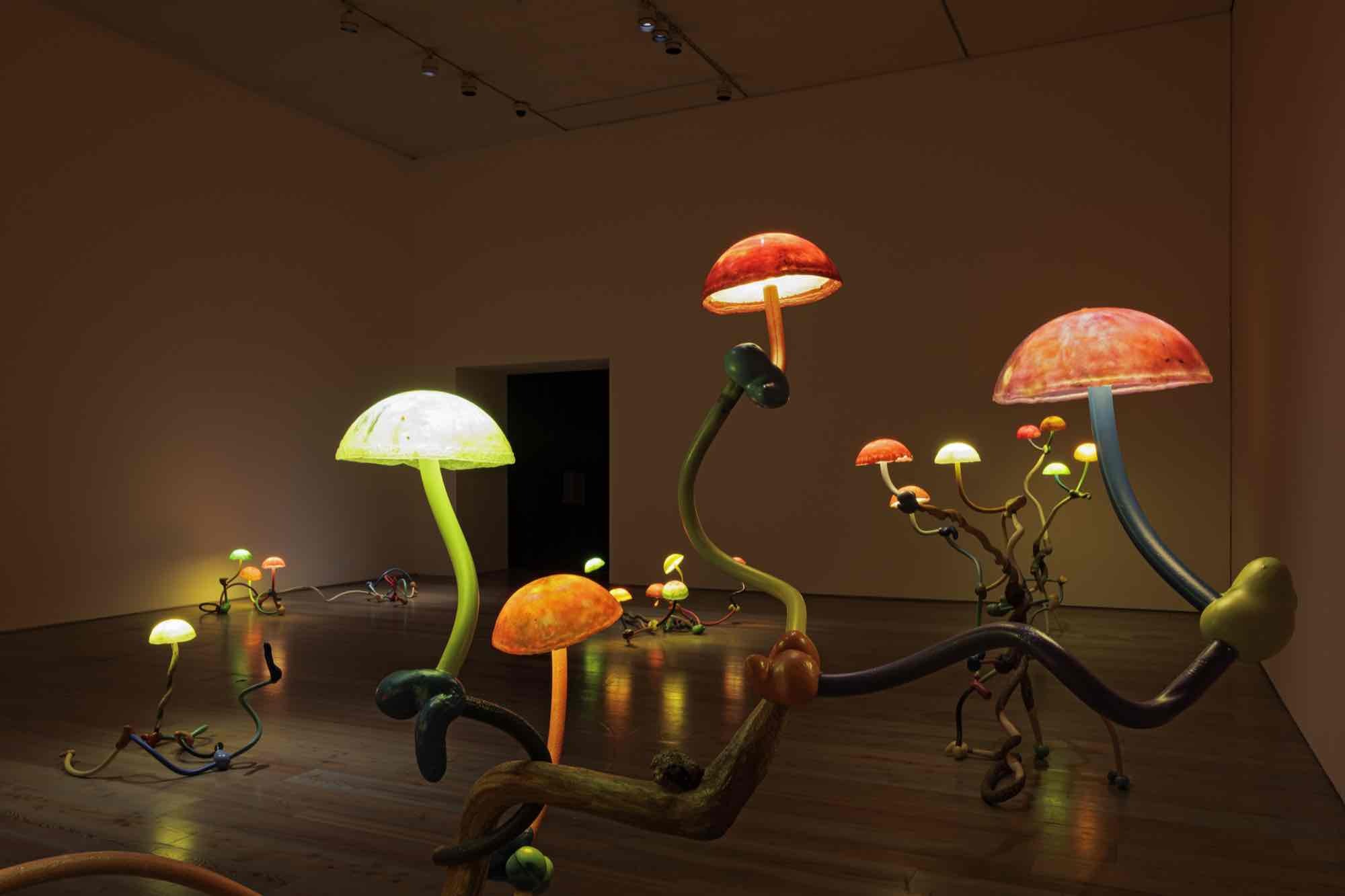
Mika Rottenberg, Lampshares, 2024
Milled reclaimed household plastic and bittersweet vines.
Lighting component: batteries, resin, and electric hardware.
Dimensions variable
Installation view of Mika Rottenberg. Antimatter Factory
at Museum Tinguely, Basel, 2024
© Mika Rottenberg, Courtesy the artist and Hauser & Wirth
Photo: 2024 Museum Tinguely, Basel; Gina Folly
Milled reclaimed household plastic and bittersweet vines.
Lighting component: batteries, resin, and electric hardware.
Dimensions variable
Installation view of Mika Rottenberg. Antimatter Factory
at Museum Tinguely, Basel, 2024
© Mika Rottenberg, Courtesy the artist and Hauser & Wirth
Photo: 2024 Museum Tinguely, Basel; Gina Folly
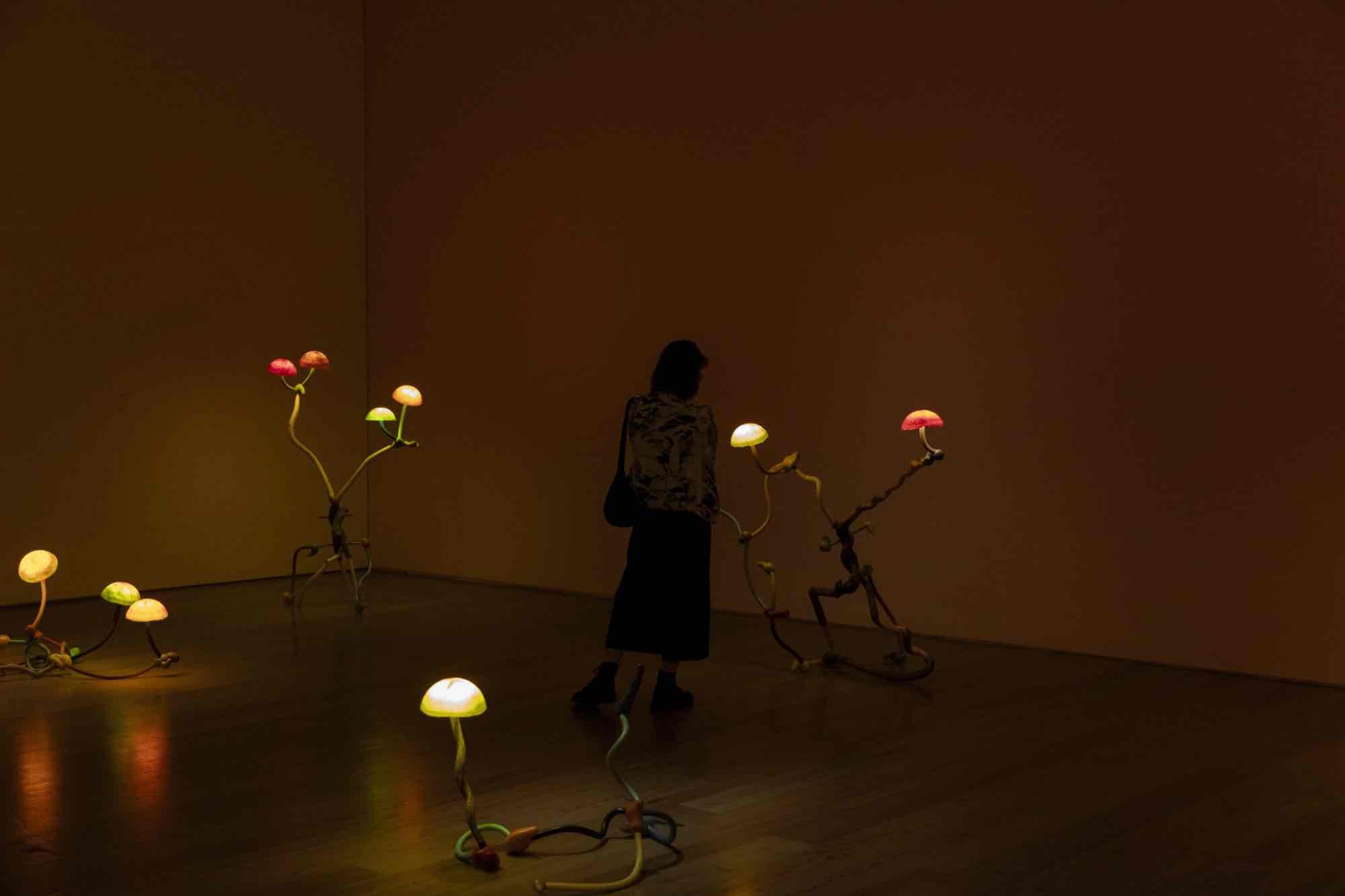
Mika Rottenberg, Lampshares, 2024
Milled reclaimed household plastic and bittersweet vines.
Lighting component: batteries, resin, and electric hardware.
Dimensions variable
Installation view of Mika Rottenberg. Antimatter Factory
at Museum Tinguely, Basel, 2024
© Mika Rottenberg, Courtesy the artist and Hauser & Wirth
Photo: 2024 Museum Tinguely, Basel; Pati Grabowicz
Milled reclaimed household plastic and bittersweet vines.
Lighting component: batteries, resin, and electric hardware.
Dimensions variable
Installation view of Mika Rottenberg. Antimatter Factory
at Museum Tinguely, Basel, 2024
© Mika Rottenberg, Courtesy the artist and Hauser & Wirth
Photo: 2024 Museum Tinguely, Basel; Pati Grabowicz
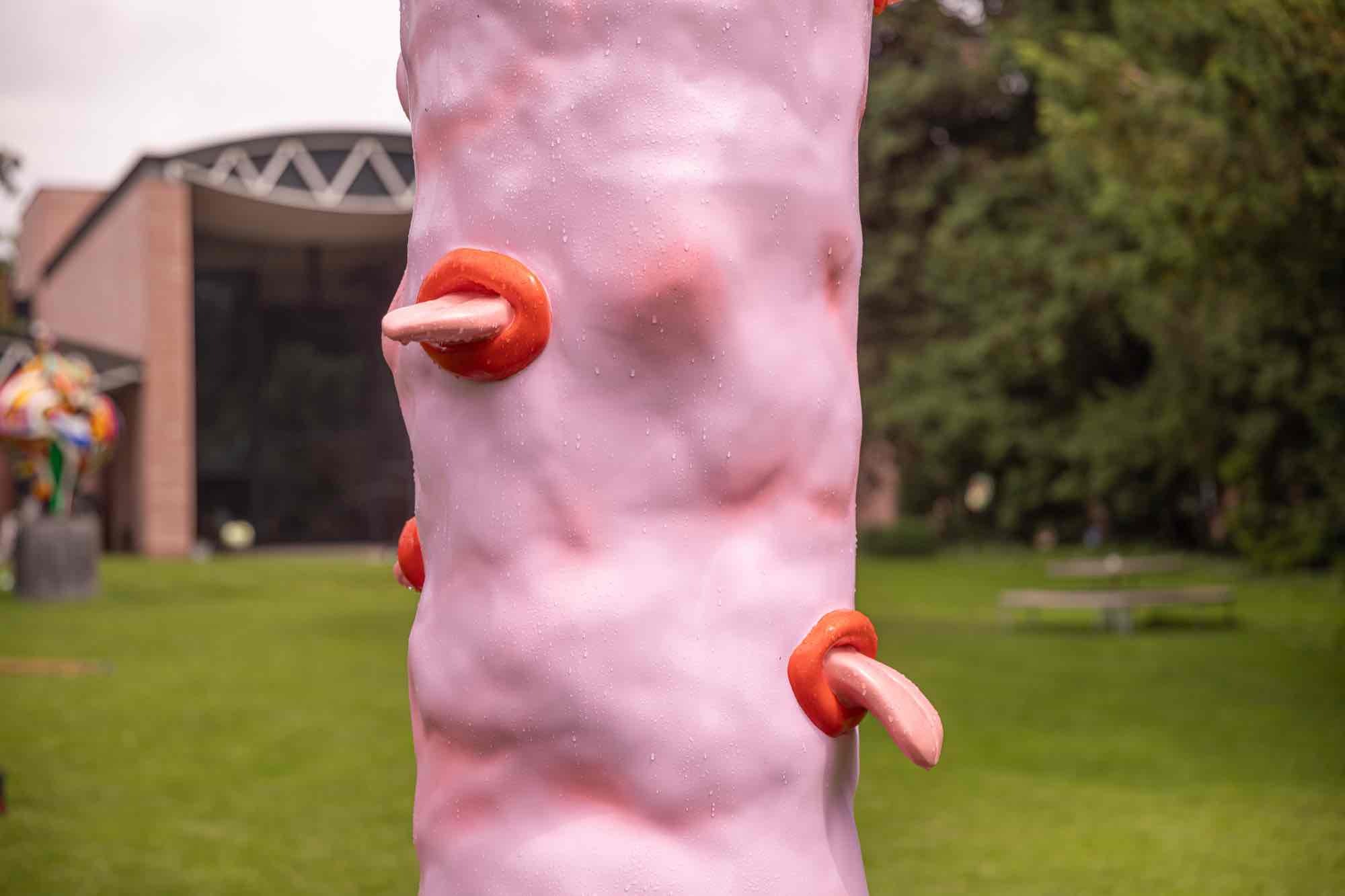
Mika Rottenberg, Foot Fountain (pink), 2024
Edition of 3 + 2AP
Acrylic resin, glass fiber, stainless steel, polyurethane paint,
water technology, bituminous
300 x 184,9 x 106,6 cm
Installation view of Mika Rottenberg. Antimatter Factory
at Museum Tinguely, Basel, 2024
© Mika Rottenberg, Courtesy the artist and Hauser & Wirth
Photo: 2024 Museum Tinguely, Basel; Matthias Willi
Edition of 3 + 2AP
Acrylic resin, glass fiber, stainless steel, polyurethane paint,
water technology, bituminous
300 x 184,9 x 106,6 cm
Installation view of Mika Rottenberg. Antimatter Factory
at Museum Tinguely, Basel, 2024
© Mika Rottenberg, Courtesy the artist and Hauser & Wirth
Photo: 2024 Museum Tinguely, Basel; Matthias Willi
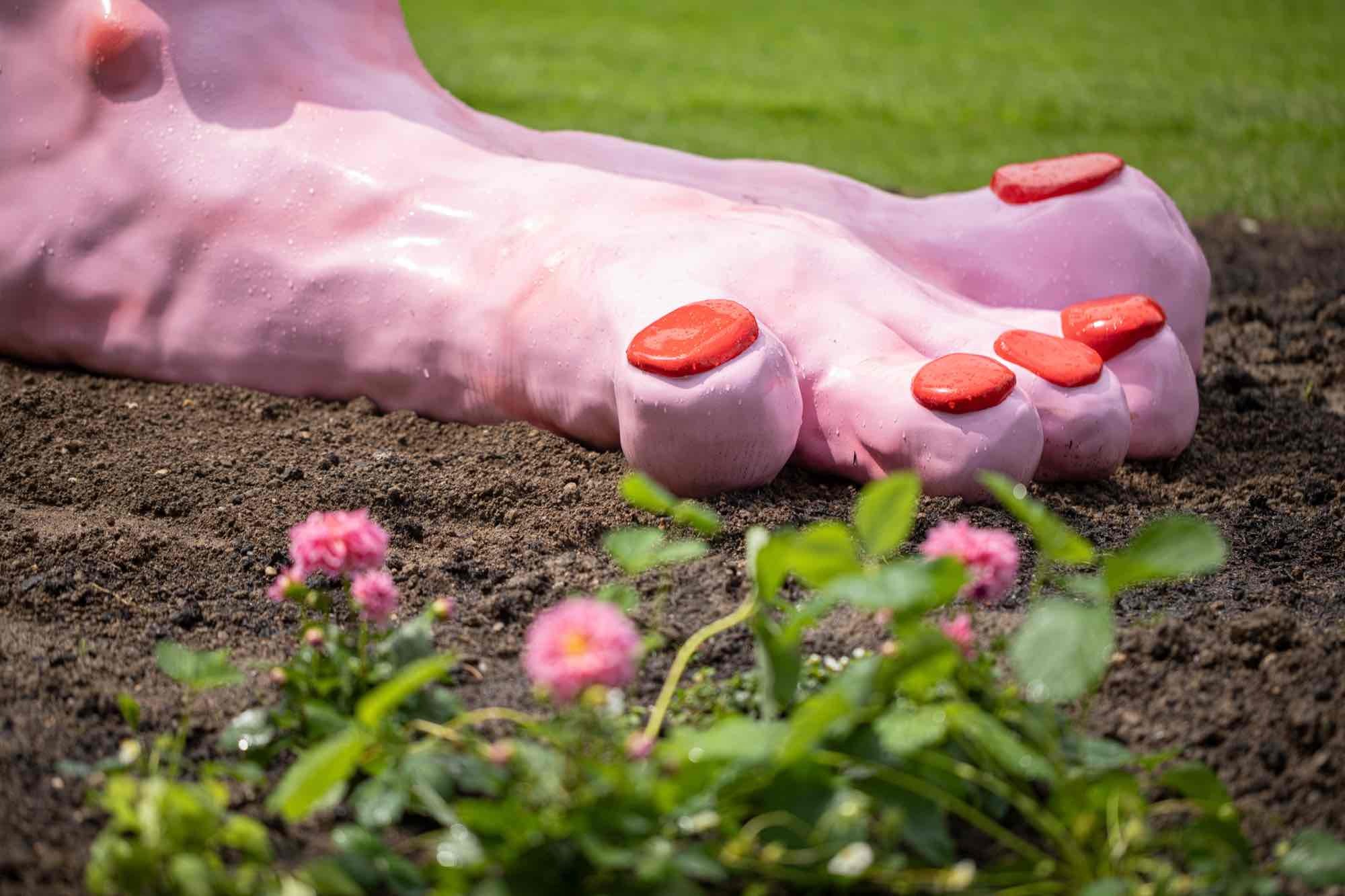
Mika Rottenberg, Foot Fountain (pink), 2024
Edition of 3 + 2AP
Acrylic resin, glass fiber, stainless steel, polyurethane paint,
water technology, bituminous
300 x 184,9 x 106,6 cm
Installation view of Mika Rottenberg. Antimatter Factory
at Museum Tinguely, Basel, 2024
© Mika Rottenberg, Courtesy the artist and Hauser & Wirth
Photo: 2024 Museum Tinguely, Basel; Matthias Willi
Edition of 3 + 2AP
Acrylic resin, glass fiber, stainless steel, polyurethane paint,
water technology, bituminous
300 x 184,9 x 106,6 cm
Installation view of Mika Rottenberg. Antimatter Factory
at Museum Tinguely, Basel, 2024
© Mika Rottenberg, Courtesy the artist and Hauser & Wirth
Photo: 2024 Museum Tinguely, Basel; Matthias Willi
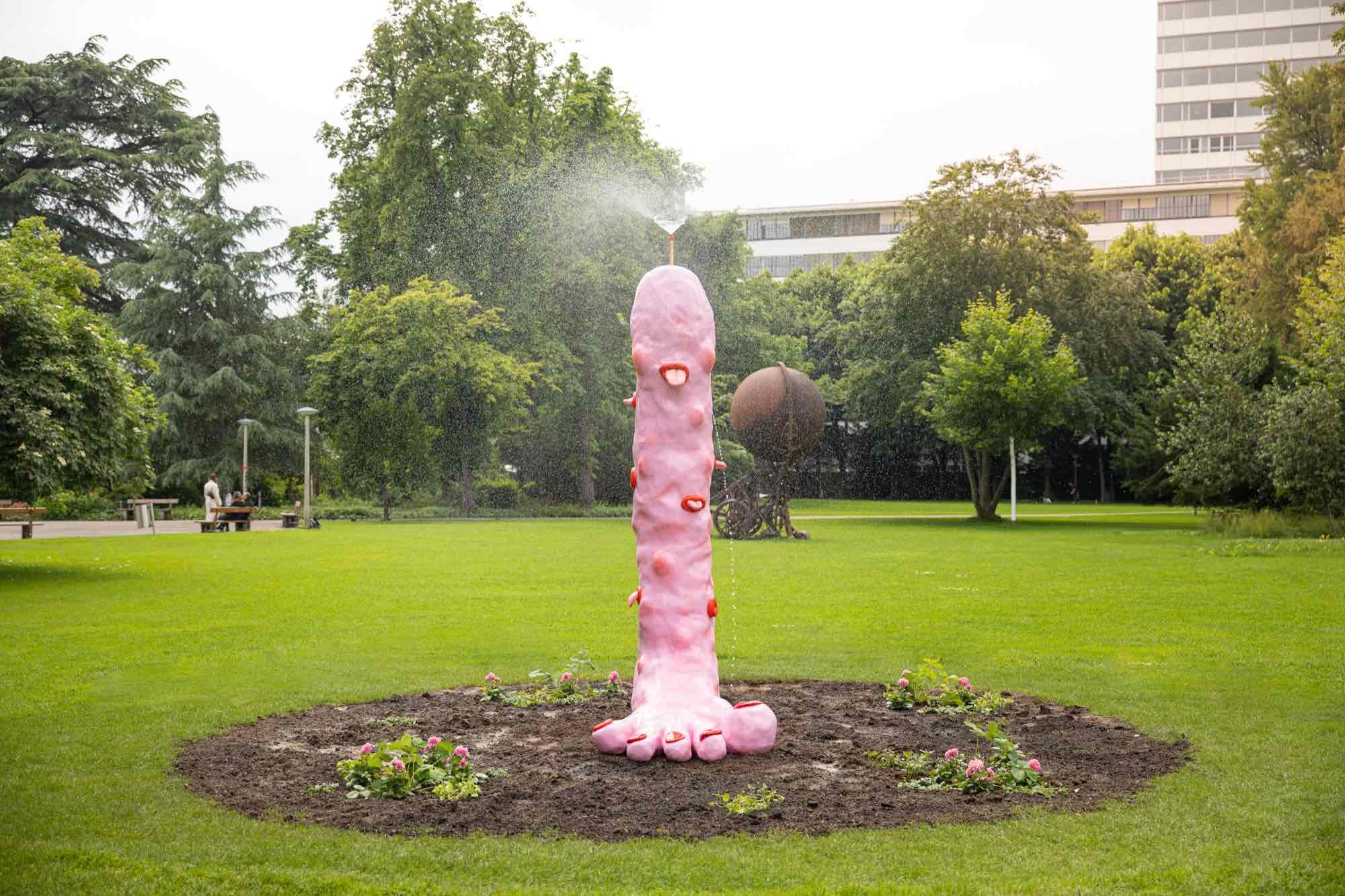
Mika Rottenberg, Foot Fountain (pink), 2024
Edition of 3 + 2AP
Acrylic resin, glass fiber, stainless steel, polyurethane paint,
water technology, bituminous
300 x 184,9 x 106,6 cm
Installation view of Mika Rottenberg. Antimatter Factory
at Museum Tinguely, Basel, 2024
© Mika Rottenberg, Courtesy the artist and Hauser & Wirth
Photo: 2024 Museum Tinguely, Basel; Matthias Willi
Edition of 3 + 2AP
Acrylic resin, glass fiber, stainless steel, polyurethane paint,
water technology, bituminous
300 x 184,9 x 106,6 cm
Installation view of Mika Rottenberg. Antimatter Factory
at Museum Tinguely, Basel, 2024
© Mika Rottenberg, Courtesy the artist and Hauser & Wirth
Photo: 2024 Museum Tinguely, Basel; Matthias Willi
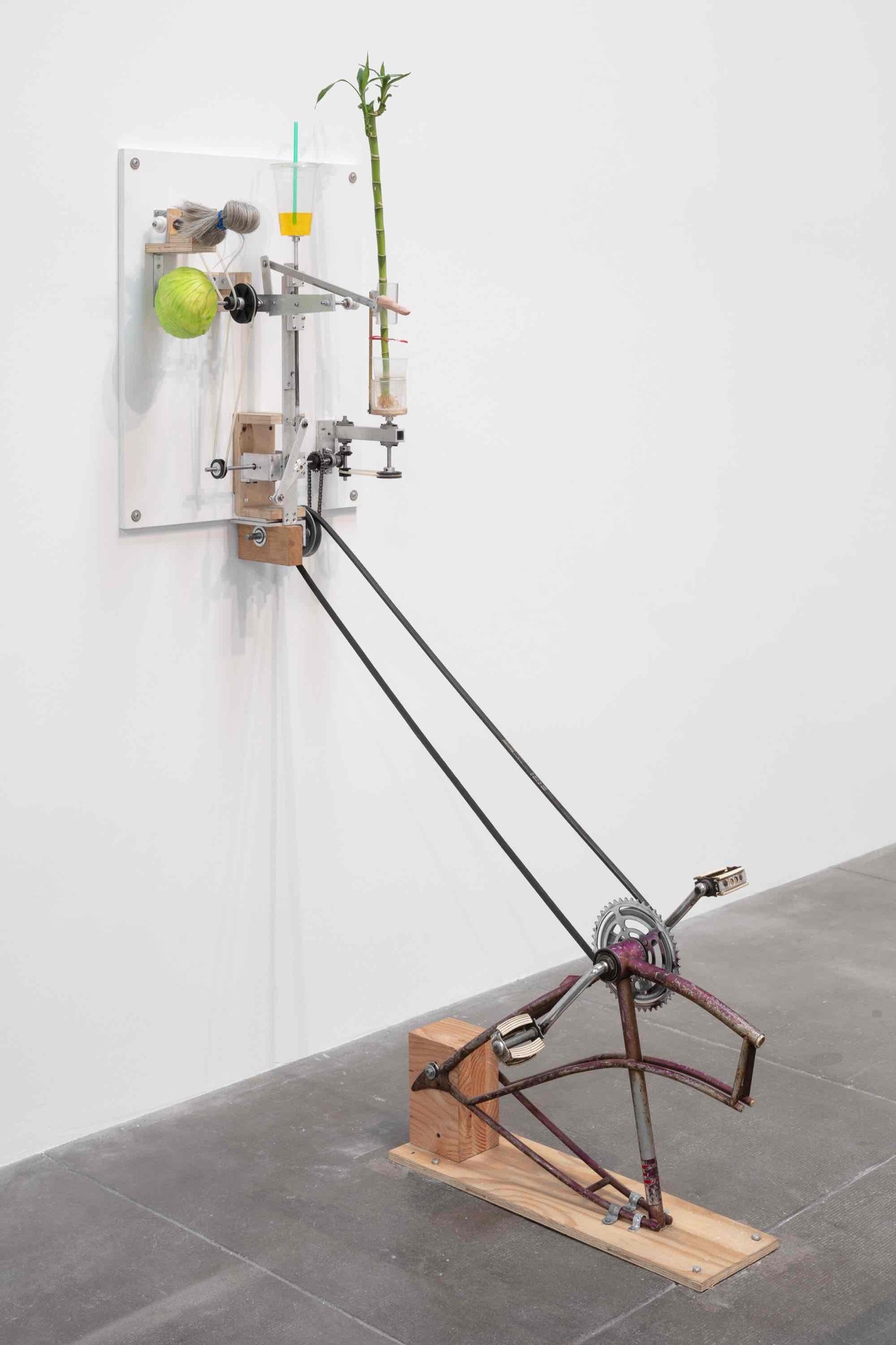
Mika Rottenberg, #33 with bamboo and bicycle, 2020
Plywood, aluminum, mechanical parts, plastic, hair
79 x 61 x 60 cm
Bike element with belt: 64 x 38 x 72,5 cm
© Mika Rottenberg, Courtesy the artist and Hauser & Wirth
Photo: Zak Kelley
Plywood, aluminum, mechanical parts, plastic, hair
79 x 61 x 60 cm
Bike element with belt: 64 x 38 x 72,5 cm
© Mika Rottenberg, Courtesy the artist and Hauser & Wirth
Photo: Zak Kelley
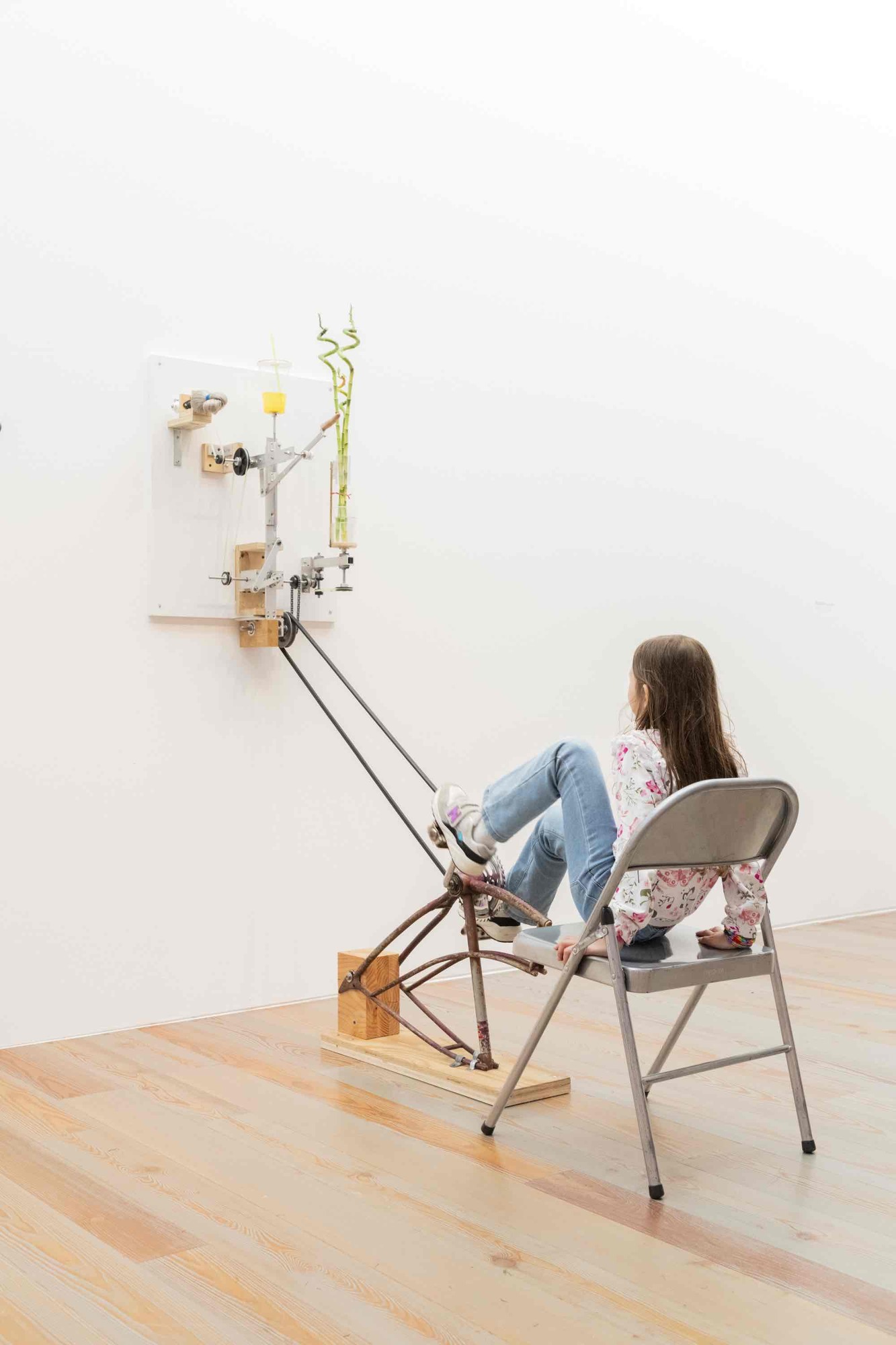
Mika Rottenberg, #33 with bamboo and bicycle, 2020
Plywood, aluminum, mechanical parts, plastic, hair
79 x 61 x 60 cm
Bike element with belt: 64 x 38 x 72,5 cm
Installation view Mika Rottenberg. Antimatter Factory
at Museum Tinguely, Basel, 2024
© Mika Rottenberg, Courtesy the artist and Hauser & Wirth
Photo: 2024 Museum Tinguely, Basel; Pati Grabowicz
Plywood, aluminum, mechanical parts, plastic, hair
79 x 61 x 60 cm
Bike element with belt: 64 x 38 x 72,5 cm
Installation view Mika Rottenberg. Antimatter Factory
at Museum Tinguely, Basel, 2024
© Mika Rottenberg, Courtesy the artist and Hauser & Wirth
Photo: 2024 Museum Tinguely, Basel; Pati Grabowicz
In one of the most comprehensive exhibitions of her work to date, Museum Tinguely offers a survey of the diverse oeuvre of Mika Rottenberg (born 1976), an artist who has attracted international attention with works at the Venice Biennale (2015), Skulptur Projekte Münster (2017) and Istanbul Biennale (2019). In surprising and playful ways, her videos reflect absurd situations shaped by the logic of capitalist production. With their painterly riots of colour, they address all of our senses, bridging the gap between continents and dimensions with ease and with tongue in cheek. As well as key video works and installations made between 2003 and 2024, the show includes her feature film REMOTE (2022). A specially made fountain sculpture in the park outside the museum will be unveiled and new, hybrid sculptures made of organic materials and reclaimed plastic will be presented. Kinetic works, some of them interactive, complete the overview that will be on display in Basel under the exhibition title Mika Rottenberg. Antimatter Factory from 5 June to 3 November 2024.
The exhibition takes its title from a research department at CERN in Geneva that conducts experiments into antimatter. Rottenberg’s time there as artist-in-residence provided the inspiration for her work Spaghetti Blockchain (2019-2024), which will be shown for the first time as a three-channel video installation during the exhibition. It addresses the exchange of energies, objects and people, combining the microscopic with the macroscopic and shifting matter through time and space as if by magic. Here, the visitors are already at the heart of Rottenberg’s artistic universe.
Jean Tinguely’s sculptures, too, could be described as factories that produce antimatter, creating immaterial poetry rather than saleable commodities, thus satirizing industrial production as an exploitative relationship between humans and machines. In her ironic takes on the surprising, often positively bizarre connections within the global production system, Rottenberg pursues this same topic. With her social surrealism, she creates parables of alienation that echo Karl Marx’s diagnosis of «a devaluation of the human world in direct proportion to the increasing value of the world of things». What makes her critique of capitalist commodity production all the more relevant is its increasing speed, the global free flow of goods (and not of people), and the digitization that detaches things from their representations. This links to another focus of Rottenberg’s art, concerning the agency of objects and materials and their inherent spirituality.
The exhibition presents a comprehensive selection of Rottenberg’s video works and video installations. Visitors are greeted by the sound of sneezing and the first video work they see is Sneeze (2012). Sneezing features in several of the artist’s works, as does her fascination with the growth of hair, fingernails and toenails as vegetative body products. These recurring themes create a thread running through the show
The video installation No Nose Knows was made in 2015 for the Venice Biennial. It shows the process of industrial pearl production at a factory in the Chinese city of Zhuji, from the insertion of a foreign body, which the oysters then coat with mother-of-pearl, through to harvesting and selection. This location is connected via cogs and transmission belts with a workplace where a woman is surrounded by bouquets of flowers that cause her to sneeze pasta dishes, while her nose gets longer and longer. The question of productivity is caricatured here as an allergic reaction that is highly personal but that is also beyond rational control.
The inspiration for Cheese (2008) came from the story of the Seven Sutherland Sisters who performed as singers around 1900 and whose super-length hair was used to promote a commercially successful hair tonic brand. Labelled «The Lucky Number 7» the bottles of tonic promised not just improved hair growth but also good fortune. Rottenberg’s walk-in installation consists of a labyrinthine structure made of rough timber in which the power of long hair combines with energy from the mist at Niagara Falls to produce the hair tonic. Via a wooden transmission contraption, a surreal link is created between this story and the production of goat’s cheese.
Entering the video installation Cosmic Generator (2017), visitors are taken on a journey through a system of narrow tunnels lit by flickering coloured lightbulbs. The shot begins in the middle of a plate with a Chinese pattern, accompanied by the kind of music often heard in Chinese restaurants, as well as screeching vehicle sounds and the fizzling of electrical short circuits. The camera then shifts to a bubbling ocean of smashed coloured lightbulbs, merging seamlessly with a panning shot across a wholesale market in Yiwu, China. The visual exuberance of the sales booths results from the specialization of these uniform structures, each selling either plastic garlands in every imaginable shade, or all kinds of fairy lights, or flashing Christmas trees, or colourful plastic flowers. A contrast to this overflowing world of commodity fetishism is provided by the saleswomen, who sit in the midst of their wares, almost invisible. The film was inspired by a visit to the border town of Mexicali, Mexico, that has a large Chinese population and many identical Chinese restaurants. Before the border fence was built, the city was connected to the neighbouring Californian city of Calexico by a system of tunnels. The film’s use of simple jump cuts to bridge distances and dimensions can be read as an allegory on the global flows of the commercial world and the geographical confinement of people.
As well as further video works and installations like Time and a Half (2003), Fried Sweat (2008), Smoky Lips (2016-19), and Untitled Ceiling Projection (2018) that span a period of almost two decades, the exhibition shows a selection of hybrid kinetic sculptures made between 2020 and 2022, some of them interactive, with surreal combinations of functions and materials, as well as a group of lamp sculptures, shown here for the first time, that combine organic structures with coloured lampshades made of reclaimed plastic. In Solitude Park, a colourful three-metre fountain sculpture in the shape of a foot has been made especially for the exhibition.
Throughout the exhibition, the visitors can watch the feature film REMOTE (2022) in the lecture hall of the museum. Made by Rottenberg during the COVID19 pandemic as a joint project with filmmaker and writer Mahyad Tousi, it is based on conversations they conducted during the lockdowns when digital communication media acquired a new importance. The film tells a fantastic tale of a post-pandemic era where physical and digital interaction unexpectedly combine and distances are abolished.
In overdrawn, absurdly surreal scenarios, Rottenberg’s art questions conditions of production and the value of labour in a Marxist sense, with a special focus on the situation of female workers. Playfully inverting cause and effect, she switches back and forth between the micro and the macro, creating an alchemy of energies and cosmologies. Viewers find themselves in a fantasy world of intoxicating sensuality and troubling illogicality that has a very liberating quality. Combining the real and the imaginary, these ecosystems of seduction and magic are marked by a physicality that is conceived of on an architectural scale: space and time, inside and outside, up and down, near and far, clean and dirty, smooth and rough. With her creative use of materials and her openness to alternative epistemologies via the agency of these materials, she anticipated developments in today’s New Materialism that explores complex links between technology, nature, and the environment
Curator: Roland Wetzel
The exhibition takes its title from a research department at CERN in Geneva that conducts experiments into antimatter. Rottenberg’s time there as artist-in-residence provided the inspiration for her work Spaghetti Blockchain (2019-2024), which will be shown for the first time as a three-channel video installation during the exhibition. It addresses the exchange of energies, objects and people, combining the microscopic with the macroscopic and shifting matter through time and space as if by magic. Here, the visitors are already at the heart of Rottenberg’s artistic universe.
Jean Tinguely’s sculptures, too, could be described as factories that produce antimatter, creating immaterial poetry rather than saleable commodities, thus satirizing industrial production as an exploitative relationship between humans and machines. In her ironic takes on the surprising, often positively bizarre connections within the global production system, Rottenberg pursues this same topic. With her social surrealism, she creates parables of alienation that echo Karl Marx’s diagnosis of «a devaluation of the human world in direct proportion to the increasing value of the world of things». What makes her critique of capitalist commodity production all the more relevant is its increasing speed, the global free flow of goods (and not of people), and the digitization that detaches things from their representations. This links to another focus of Rottenberg’s art, concerning the agency of objects and materials and their inherent spirituality.
The exhibition presents a comprehensive selection of Rottenberg’s video works and video installations. Visitors are greeted by the sound of sneezing and the first video work they see is Sneeze (2012). Sneezing features in several of the artist’s works, as does her fascination with the growth of hair, fingernails and toenails as vegetative body products. These recurring themes create a thread running through the show
The video installation No Nose Knows was made in 2015 for the Venice Biennial. It shows the process of industrial pearl production at a factory in the Chinese city of Zhuji, from the insertion of a foreign body, which the oysters then coat with mother-of-pearl, through to harvesting and selection. This location is connected via cogs and transmission belts with a workplace where a woman is surrounded by bouquets of flowers that cause her to sneeze pasta dishes, while her nose gets longer and longer. The question of productivity is caricatured here as an allergic reaction that is highly personal but that is also beyond rational control.
The inspiration for Cheese (2008) came from the story of the Seven Sutherland Sisters who performed as singers around 1900 and whose super-length hair was used to promote a commercially successful hair tonic brand. Labelled «The Lucky Number 7» the bottles of tonic promised not just improved hair growth but also good fortune. Rottenberg’s walk-in installation consists of a labyrinthine structure made of rough timber in which the power of long hair combines with energy from the mist at Niagara Falls to produce the hair tonic. Via a wooden transmission contraption, a surreal link is created between this story and the production of goat’s cheese.
Entering the video installation Cosmic Generator (2017), visitors are taken on a journey through a system of narrow tunnels lit by flickering coloured lightbulbs. The shot begins in the middle of a plate with a Chinese pattern, accompanied by the kind of music often heard in Chinese restaurants, as well as screeching vehicle sounds and the fizzling of electrical short circuits. The camera then shifts to a bubbling ocean of smashed coloured lightbulbs, merging seamlessly with a panning shot across a wholesale market in Yiwu, China. The visual exuberance of the sales booths results from the specialization of these uniform structures, each selling either plastic garlands in every imaginable shade, or all kinds of fairy lights, or flashing Christmas trees, or colourful plastic flowers. A contrast to this overflowing world of commodity fetishism is provided by the saleswomen, who sit in the midst of their wares, almost invisible. The film was inspired by a visit to the border town of Mexicali, Mexico, that has a large Chinese population and many identical Chinese restaurants. Before the border fence was built, the city was connected to the neighbouring Californian city of Calexico by a system of tunnels. The film’s use of simple jump cuts to bridge distances and dimensions can be read as an allegory on the global flows of the commercial world and the geographical confinement of people.
As well as further video works and installations like Time and a Half (2003), Fried Sweat (2008), Smoky Lips (2016-19), and Untitled Ceiling Projection (2018) that span a period of almost two decades, the exhibition shows a selection of hybrid kinetic sculptures made between 2020 and 2022, some of them interactive, with surreal combinations of functions and materials, as well as a group of lamp sculptures, shown here for the first time, that combine organic structures with coloured lampshades made of reclaimed plastic. In Solitude Park, a colourful three-metre fountain sculpture in the shape of a foot has been made especially for the exhibition.
Throughout the exhibition, the visitors can watch the feature film REMOTE (2022) in the lecture hall of the museum. Made by Rottenberg during the COVID19 pandemic as a joint project with filmmaker and writer Mahyad Tousi, it is based on conversations they conducted during the lockdowns when digital communication media acquired a new importance. The film tells a fantastic tale of a post-pandemic era where physical and digital interaction unexpectedly combine and distances are abolished.
In overdrawn, absurdly surreal scenarios, Rottenberg’s art questions conditions of production and the value of labour in a Marxist sense, with a special focus on the situation of female workers. Playfully inverting cause and effect, she switches back and forth between the micro and the macro, creating an alchemy of energies and cosmologies. Viewers find themselves in a fantasy world of intoxicating sensuality and troubling illogicality that has a very liberating quality. Combining the real and the imaginary, these ecosystems of seduction and magic are marked by a physicality that is conceived of on an architectural scale: space and time, inside and outside, up and down, near and far, clean and dirty, smooth and rough. With her creative use of materials and her openness to alternative epistemologies via the agency of these materials, she anticipated developments in today’s New Materialism that explores complex links between technology, nature, and the environment
Curator: Roland Wetzel
